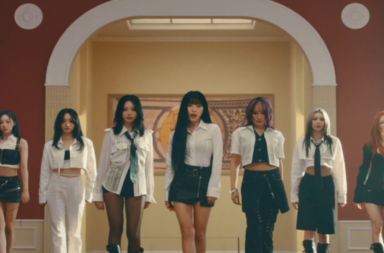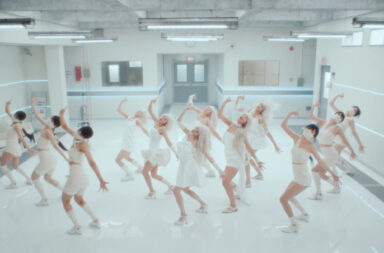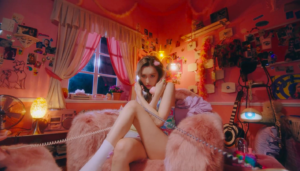
The great thing about the ‘retro’ concept in pop music is that it will always be an infinite resource, hoovering up new reference points as culture moves forward past each trend and period. Anything from over five years ago is fair game, and Sunmi has long been aware of this in her work. “Siren” was big, booming eighties synths, “Tail” had hints of sixties swing and bounce in its rhythms, and “When We Disco”, well, the clue’s in the title. Her latest single, “You Can’t Sit With Us”, is the, somehow campier, descendant of “Disco”, mashing together visual references from the nineties and noughties with classic eighties pop sounds.
In combining together so many of these visual retro nods—and there are quite a few— Sunmi creates an MV that is perhaps her most wildly camp yet. But beyond the retro musical stylings and occasional costume choices, in this MV we see her fully leaning into a cinematic mode, utilising genres and specific film references to create a layered slice of kitsch that ultimately cracks to peer into itself.
The most attention-grabbing element of this video is just how filmic it is, represented through visual cues, styling, cinematography and set design. The specific references in this video are often hilariously overt, hinting at their ironic intent. Just in the song’s title, there is a seemingly clear allusion to the line shrieked by Gretchen Weiners in 2004’s Mean Girls. There are also shots of Sunmi sitting whilst speaking into two phones, reminiscent of the same movie’s ‘three-way call’ scene, and a moment where, in anger, she destroys parts of her room after putting down the phone, much like the film’s antagonist Regina George. Here, deadpan Sunmi is the teen queen, the Regina of the MV.
This status of Sunmi as the lofty head of her social circle is also echoed by slightly subtler references to Clueless: Sunmi’s delightfully chunky Mac computer displays an interface very similar to Cher Horowitz’s wardrobe ‘tech’, and one of her bedroom outfits is a yellow and black spotted mini dress that echoes Cher’s own iconic combination of the colours in the beginning of the film.
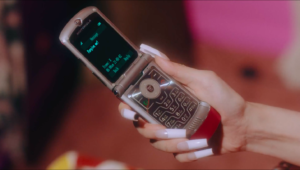
Using these two references, Sunmi positions herself in the MV’s bedroom scenes as a bratty, popular teenager getting what she wants. And not only a teenager, but one straddling the nineties/noughties aesthetics of these two films. There are delightful shots of both a crystal-encrusted cord phone, and a Motorola Razr style flip phone during this portion of the MV. We are in a simpler past here, a world of bitchy teenagers and tantrums, small phones and big computers. This is a world of bright colours (literally, in Sunmi’s outfits and room décor), and thus far there is no space for nuance.
This bold, self-consciously shallow aesthetic is carried throughout the rest of the MV. The period-accurate fashion references continue, with Sunmi styled in double denim and gold chains, long French nails and another Cher-esque outfit in the form of a pink-cheque two piece. This is nothing new for K-pop or Sunmi, and neither is the musical style, which, jarringly, is a decade older in its eighties stylings. The synths here could almost come from a video game arcade, which, whilst fun, doesn’t fit with the styling choices that Sunmi has opened her video with. Her answer to this? Add in more cinema references, and a few zombies for the full gaming experience.
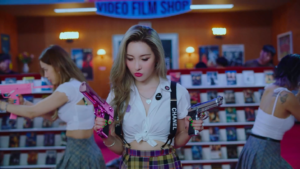
At around the mid-point of the MV, the primary setting moves to a video store, where Sunmi and friends battle a sudden horde of zombies, led by a man, holding a ‘forgive me’ sign, that we met earlier. The name of this video store? From Dusk Til Dawn, the name of a Robert Rodriguez movie about criminals and vampire bars. Dressed here in full ‘bad-ass school girl’ mode (tied-up white shirt, plaid skirt, knee-high socks and chunky boots), Sunmi becomes a game avatar ready for battle, her outfit nodding again to nineties icons, this time Britney Spears. The ensuing scene sees Sunmi take out zombies in full horror-schlock mode, a bright pink gun popping zombie heads with comic book blood.
These props and cinematography transform the MV into a brief one player shooting game, with the camera swerving and running with our main avatar as she destroys her enemies. One shot even sees her slow-motion jumping into the air while firing two guns: The Matrix would be proud. It’s important to note that this specific fight scene doesn’t accompany the song but is instead a brief break from it. It isn’t directly representing anything in the music or lyrics, but is instead a total diversion. It’s a new direction from the bratty character set-up earlier in the MV, an addition of yet another form of camp that shows us how Sunmi isn’t taking things too seriously. By adding in Matrix and Dusk Til Dawn, two high-action romps, she swerves the MV into a bolder vision of kitsch than the ‘Teen Queen Bee’ image could give.
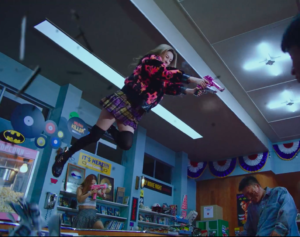
But Sunmi doesn’t even stop here, layering on yet another genre twist to subvert the camp mood of the video. After teen comedy and zombie horror, what stranger swerve than a romance storyline? As mentioned above, in the earlier moments of the MV we see Sunmi stare out of her window at a man holding a ‘forgive me’ sign. Though he, for some reason, becomes the lead zombie in the MV’s video game section, at the end of the battle, Sunmi leaves the store and approaches him, the cue for him to propose. After brief, dreamy shots of her new fiancé and the ring on her finger, the video continues with more dance sequences, leaving little explanation for what this could mean. Is this just a curve ball for the sake of it?
Possibly, but in the closing shots of the video, Sunmi is in an entirely different outfit, embracing this man, and surrounded by armed police, with sirens blaring. The lighting is dark, save for the searchlights blazing on the couple. The final twist in Sunmi’s high camp tale, she teases the possibility that everything witnessed before was in fact an elaborate, and possibly dangerous, fantasy. This fits in neatly with the lyrical mood of the song, swinging wildly from spite to affection:
And every time I see you I hate you
But I don’t think I can do it without you
Through this climactic romantic storyline, we see the flip side of the high camp vitriol that forms the main body of the song:
You can’t sit with us, oh! I hate you
When I think of you, I’m feelin’ faded
The surrealism of this ending highlights the jarring nature of these two attitudes co-existing in the song, and its simplicity moves us out of the grand cinematic world we have just been revelling in. These final shots are not accompanied by music, and the contrast of dark shadows and strong lights creates a minimalism, a moment of simple quiet. This end scene is Sunmi, quite literally, stepping out of the cinema and into real life, the more tender part of her character asking for her lover to “look at me now baby”.
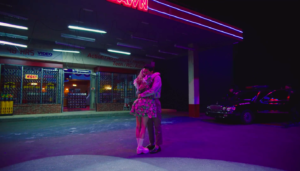
The overall structure of the video echoes the song in having this moment of tenderness be only a brief one in an otherwise kitsch cinema romp. The song repeats the refrains of “you can’t sit with us” and “I hate you” throughout, and the video mirrors this with mostly campy aesthetics to match these childish, sniping statements. But there is a softer side, a brief crack of affection in the stern exterior. These vicious statements, presented in the MV through cinematic references and stylings, hint at an overall artifice to the statements themselves: they are a construction, a fiction for entertainment purposes.
The retro element of the MV and song comes into play here as well. By harkening back to previous eras, and especially such camp moments in these eras, Sunmi is evoking the idea of the past as simple, a source of fun stories and costumes that one can put on and play with. “You Can Sit With Us” is not shy to jump in to these concepts and play around with them, ultimately peeling away from them to reveal something more complex underneath. Sunmi has made a greatly mischievous MV here, with the kitsch, camp and play ultimately serving as a cinema screen that, while fun, is an artifice, with a more complicated world lying outside.
YouTube, Images via ABYSS COMPANY.
